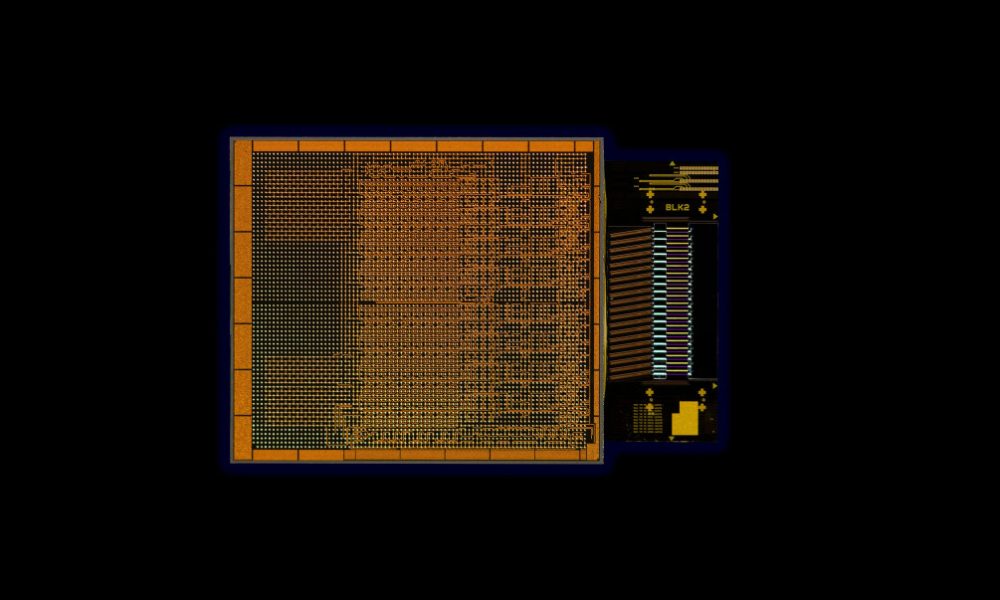Intel Corporation has reached a revolutionary milestone in integrated photonics technology, Integrated photonics technology involves the integration of photonic devices, such as lasers, modulators, and detectors, onto a single microchip using semiconductor fabrication techniques similar to those used for electronic integrated circuits. This technology allows for the manipulation and transmission of light signals on a micro-scale, offering significant advantages in terms of speed, bandwidth, and energy efficiency compared to traditional electronic circuits.
Today, Intel introduced the first fully integrated optical compute interconnect (OCI) chiplet co-packaged with an Intel CPU at the Optical Fiber Communication Conference (OFC) 2024. This OCI chiplet, designed for high-speed data transmission, signifies a significant advancement in high-bandwidth interconnects, aimed at enhancing AI infrastructure in data centers and high-performance computing (HPC) applications.
Key Features and Capabilities:
- High Bandwidth and Low Power Consumption:
- Supports 64 channels of 32 Gbps data transmission in each direction.
- Achieves up to 4 terabits per second (Tbps) bidirectional data transfer.
- Energy-efficient, consuming only 5 pico-Joules (pJ) per bit compared to pluggable optical transceiver modules at 15 pJ/bit.
- Extended Reach and Scalability:
- Capable of transmitting data up to 100 meters using fiber optics.
- Supports future scalability for CPU/GPU cluster connectivity and new compute architectures, including coherent memory expansion and resource disaggregation.
- Enhanced AI Infrastructure:
- Addresses the growing demands of AI infrastructure for higher bandwidth, lower power consumption, and longer reach.
- Facilitates the scalability of AI platforms, supporting larger processing unit clusters and more efficient resource utilization.
Technical Advancements:
- Integrated Silicon Photonics Technology: Combines a silicon photonics integrated circuit (PIC) with an electrical IC, featuring on-chip lasers and optical amplifiers.
- High Data Transmission Quality: Demonstrated with a transmitter (Tx) and receiver (Rx) connection over a single-mode fiber (SMF) patch cord, showcasing a 32 Gbps Tx eye diagram with strong signal quality.
- Dense Wavelength Division Multiplexing (DWDM): Utilizes eight fiber pairs, each carrying eight DWDM wavelengths, for efficient data transfer.
Impact on AI and Data Centers:
- Boosts ML Workload Acceleration: Enables significant performance improvements and energy savings in AI/ML infrastructure.
- Addresses Electrical I/O Limitations: Provides a superior alternative to electrical I/O, which is limited in reach and bandwidth density.
- Supports Emerging AI Workloads: Essential for the deployment of larger and more efficient machine learning models.
Future Prospects:
- Prototype Stage: Intel is currently working with select customers to co-package OCI with their system-on-chips (SoCs) as an optical I/O solution.
- Continued Innovation: Intel is developing next-generation 200G/lane PICs for emerging 800 Gbps and 1.6 Tbps applications, along with advancements in on-chip laser and SOA performance.
Intel’s Leadership in Silicon Photonics:
- Proven Reliability and Volume Production: Over 8 million PICs shipped, with over 32 million integrated on-chip lasers, showcasing industry-leading reliability.
- Advanced Integration Techniques: Hybrid laser-on-wafer technology and direct integration provide superior performance and efficiency.
Intel’s OCI chiplet represents a significant leap forward in high-speed data transmission, poised to revolutionize AI infrastructure and connectivity.



